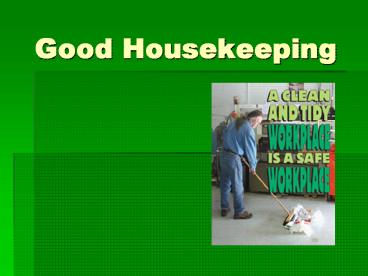Good Housekeeping - PowerPoint PPT Presentation
1 / 15
Title:
Good Housekeeping
Description:
Wet or oily surfaces. Spills. Loose rugs or mats. Causes of Trips: Poor lighting ... Do the containers for the hazardous wastes (oily rags and flammables) have lids? ... – PowerPoint PPT presentation
Number of Views:40594
Avg rating:5.0/5.0
Title: Good Housekeeping
1
Good Housekeeping
2
Introduction
- Good Housekeeping is the foundation for accident
prevention - A neat, clean and orderly workplace is a safe
workplace - The benefits of keeping a tidy workplace far
exceed the small additional effort required
3
Benefits of Good Housekeeping
- Safe, healthy workplace
- Little or no accidents or fire hazards
- Less accidents ?
- Lower EMR/ RIR ?
- Lower insurance costs ?
- Money savings!
4
More Benefits
- Efficient working conditions ?
- Increased productivity
- Increased Worker Pride ?
- Increased Productivity Increased Quality
- Increased Productivity ?
- Saving Time
- Saving time Saving money
- On Time Delivery
5
Results of Poor Housekeeping
- Throughout the nation, over 1 million people
suffer from injuries caused by slips, trips, and
falls each year - 15 of time-loss injuries are a result of falls
- 60 of these falls are from slips and trips
- Causes of slips
- Wet or oily surfaces
- Spills
- Loose rugs or mats
- Causes of Trips
- Poor lighting
- Clutter in the way
- Obstructed view
- Wrinkled carpeting
6
Injuries from Slips, Trips, and Falls
- Stains/ Sprains
- Torn ligaments
- Broken bones
- Back or spine injury
- Death
7
Accident Prevention
- Slips, trips, and falls are the number one
preventable accident in the workplace - Good Housekeeping is the basis for preventing
slips, trips, and falls - Cleaning up spills immediately
- Marking wet areas
- Mopping or sweeping debris from floor
- Removing obstacles from walkways and keeping them
free of clutter - Securing mats and rugs to floor to lay flat on
floor - Covering/ taping down cables across walkways
- Keeping work areas well lit
- Put away tools
8
Fire Prevention
- Store flammable and combustible liquid in
approved flammable liquid containers - Keep reactive chemicals separated
- Keep combustibles away from electrical equipment
and machinery - Clearly mark exits in case of emergency
9
OSHA 1926.25
- During the course of construction, alteration, or
repairs, form and scrap lumber with protruding
nails and all other debris, shall be kept cleared
from work areas, passageways, and stairs, in and
around buildings or other structures. - Combustible scrap and debris shall be removed at
regular intervals during the course of
construction. Safe means shall be provided to
facilitate such removal. - Containers shall be provided for the collection
and separation of waste, trash, oily and used
rags and other refuse. Containers used for
garbage and other oil\y, flammable or hazardous
wastes, such as caustics, acids, harmful dusts,
etc. shall be disposed of at frequent intervals.
10
Safety Procedures
- Noncombustible scrap metal and debris shall be
removed from work areas, passageways, stairs and
from around buildings - Combustible materials must be removed at regular
intervals without hazard to those removing
hazardous material - Protruding nails shall be removed from lumber
before stacking - Waste shall be collected in containers before
disposal. Separate containers with lids shall be
used for hazardous waste.
11
Safety Procedures cont. . .
- Store tools and materials neatly and out of the
way in storage bins or lockers. - Ensure that materials stored at overhead levels
are secured. - Never throw waste or materials from a building or
structure. - Where falling debris can potentially occur, guard
the area and use signage requiring workers to
wear hard hats - Control muddy areas by placing fill to decrease
the risk of slipping accidents
12
Example Plan for Good Housekeeping
- Set aside time for housekeeping on a daily basis
- Evaluate your workspace and remove potential
hazards before starting work - Clean up as you go
- Inspect and clean PPE before each use
- Use the right equipment for housekeeping tasks
- Brooms, vacuums, mops, cleaning compounds
- Eye protection, gloves, proper shoes, dust masks
13
Housekeeping Checklist
- Yes No
- Are protruding nails, form, scrap lumber, and
other debris kept clear from work areas,
passageways, and stairs, in and around buildings
or other structures? - Are combustible scrap and debris being removed at
regular intervals during the course of
construction? - Are containers being provided for the collection
and separation of waste and trash? - Do the containers for the hazardous wastes (oily
rags and flammables) have lids?
14
Things to Remember
- Slips, trips, and falls can be easily prevented
with good housekeeping - A neat and clean workplace is a safe workplace
- Be aware of potential housekeeping hazards by
cleaning as you go - Identify and eliminate hazards before you start
work - Good Housekeeping Benefits Everyone!
15
Works Cited
- http//www.cdc.gov/eLCOSH/docs/d0300/d000396/d0003
96.html - http//www.safetyworld.com/topics/house.htm
- http//safety.blr.com/results.cfm/type/55/topic/11
5/state/155 - http//www.scif.com/safety/safetymeeting/Article.a
sp?ArticleID398 - http//www.mobilityfreedom.org/images/money.jpg
- http//images.google.com/images?um1hlenqclean
ing











![[PDF]DOWNLOAD Good Housekeeping Kids Cook!: 100+ Super-Easy, Delicious Recipes - A Cookbook (Volume 1) (Good Housekeeping Kids Cookbooks) PowerPoint PPT Presentation](https://s3.amazonaws.com/images.powershow.com/10081553.th0.jpg?_=20240719049)
![[PDF]DOWNLOA Good Housekeeping Kids Cook!: 100+ Super-Easy, Delicious Recipes - A Cookbook (Volume 1) (Good Housekeeping Kids Cookbooks) PowerPoint PPT Presentation](https://s3.amazonaws.com/images.powershow.com/10080895.th0.jpg?_=202407180412)






![[PDF]❤️DOWNLOAD⚡️ Good Housekeeping Kids Cook!: 100+ Super-Easy, Delicious Recipes - A Coo PowerPoint PPT Presentation](https://s3.amazonaws.com/images.powershow.com/10085768.th0.jpg?_=20240725066)



![[PDF]❤️DOWNLOAD⚡️ Good Housekeeping Kids Cook!: 100+ Super-Easy, Delicious Recipes - A Cookbook PowerPoint PPT Presentation](https://s3.amazonaws.com/images.powershow.com/10073754.th0.jpg?_=20240705047)







